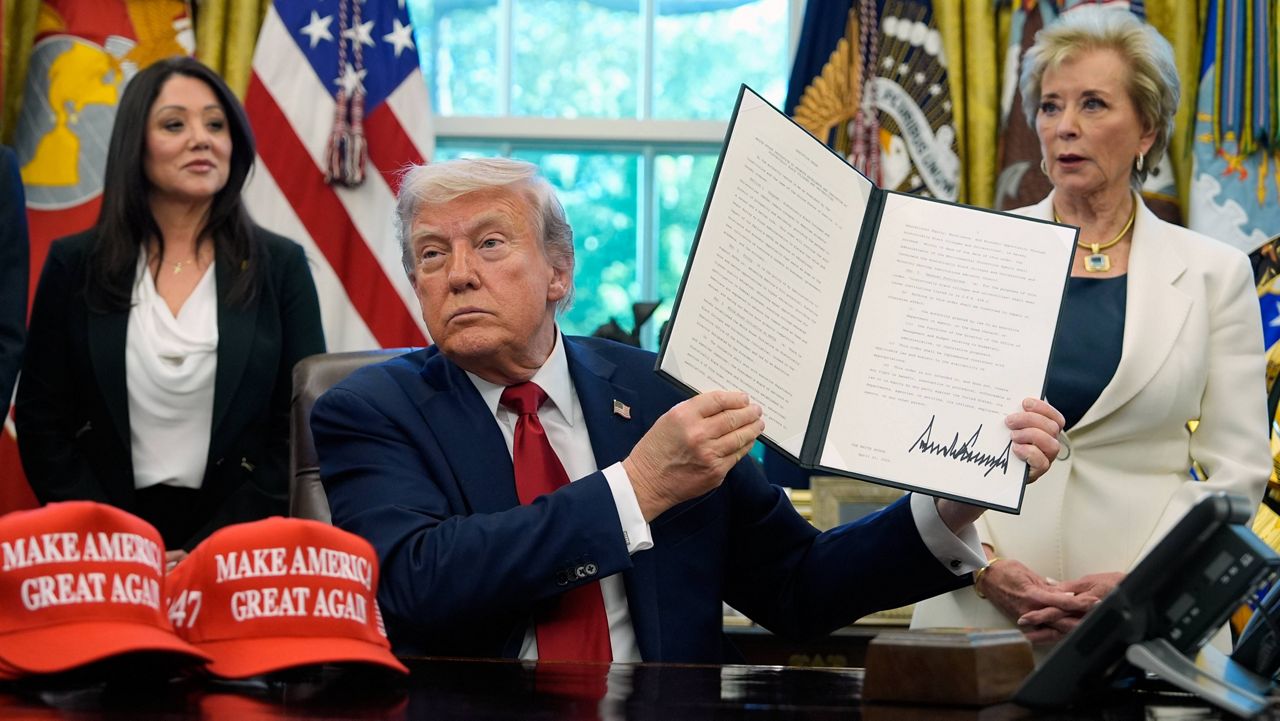WASHINGTON — House Republicans this week will take up the Senate’s latest version of a blueprint, known as a budget resolution, that serves as the guide to ultimately passing President Donald Trump’s legislative agenda, even as it faces an uncertain future while some conservatives in the chamber blast it.
Speaking at his weekly news conference Tuesday, Speaker Mike Johnson, R-La., told reporters that the budget resolution will see action this week. He warned that time was of the essence, citing the looming deadline to pass a debt limit increase before the U.S. could default, the expiration of Trump’s 2017 tax cuts at the end of the year, the need for more resources at the border and “unsettled” markets, which have been rattled since the president announced sweeping new tariffs on trading partners around the globe last week.
"And for all those reasons, we have no luxury of complacency,” Johnson said.
It comes after Trump on Monday reiterated his support for the blueprint that passed in the Senate last week — despite two Republicans joining with all Democrats to vote against it. In a post on Truth Social, the president said the plan has his “Complete and Total Endorsement and Support” before urging the lower chamber to move on it quickly.
“THE HOUSE MUST PASS THIS BUDGET RESOLUTION, AND QUICKLY – MAKE AMERICA GREAT AGAIN!” Trump wrote.
The Senate’s 70-page resolution sets the basic outlines for a bill enacting Trump’s agenda on the border, defense, energy and taxes and would allow Republicans to begin the process of drafting the actual legislation to do so. Passing such a blueprint is a necessary first step in the process – known as budget reconciliation — that Republicans plan to use to avoid needing any Democratic support in the Senate.
The House passed its own resolution weeks ago, but both chambers have to pass ones that mirror one another before they can begin crafting the final legislation on Trump’s biggest priorities.
Johnson on Tuesday made the case that the Senate resolution keeps the same overall instructions for crafting the final legislation that the House GOP had in its version, insisting that their “objectives remain intact.”
Nevertheless, its fate this week is unclear in the lower chamber — where the GOP holds a narrow majority — as a handful of House Republicans known for pushing back on government spending are signaling they will oppose the resolution.
“If the Senate’s ‘Jekyll and Hyde’ budget is put on the House floor, I will vote no,” Rep. Chip Roy, R-Texas, wrote on X, going on to call the Senate bill a “path to failure.”
The chair of the conservative House Freedom Caucus, Rep. Andy Harris, R-Md., meanwhile, specifically criticized spending cuts in the Senate version as compared to the House one.
“The Senate is free to put pen to paper to draft its reconciliation bill, but I can’t support House passage of the Senate changes to our budget resolution until I see the actual spending and deficit reduction plans to enact President Trump’s America First agenda,” he wrote in a post on X.
In a notable statement, the chair of the House Budget Committee, Rep. Jodey Arrington, R-Texas — a key player in the budget reconciliation process — similarly criticized the level of cuts in the Senate resolution, calling it “unserious and disappointing.” He did not say how he would vote, but he also blasted a tactic Senate Republicans are seeking to use to extend Trump’s tax cuts.
Democrats, who are blasting the resolution, predicted Tuesday that most Republicans pledging to oppose the resolution this week will ultimately “cave.”
“House Republicans generally say one thing when they’re in an elevator with us and then they do something else when they are given an opportunity to vote on the floor,” Rep. Pete Aguilar, D-Calif., told reporters.
In a “Dear Colleague” letter to Democrats on Monday, House Minority Leader Hakeem Jeffries, D-N.Y., called the bill “reckless” and asked for “maximum attendance” from his members Wednesday to vote in force against the resolution.
As it stands now, the Senate resolution seeks to permanently extend and add to Trump’s signature 2017 tax cuts while strengthening funding for defense and border priorities, setting a savings floor that directs committees to find places to cut spending and raising the debt limit by $5 trillion — a major priority for the president, who originally wanted it taken care of before he returned to office. Lifting the ceiling — a major political headache in recent years — through the reconciliation process means the GOP would not have to negotiate with Democrats on it.
The Senate is seeking to lift the ceiling by a slightly higher figure than the House — where some fiscally conservative members have long been critical of debt limit increases. Senators argued the $5 trillion lift in their resolution, compared to the House’s $4 trillion, would make it so that they don’t have to deal with the issue again until after the 2026 midterm elections.
Meanwhile, the two chambers are also off on their savings figures, although they can be adjusted. The Senate resolution sets a lower minimum for cuts by committees involved in funding for certain social safety net programs than the House one, which led to uneasiness from some Republicans in the lower chamber over potential cuts to items such Medicaid.
The resolution also looks to make Trump’s 2017 tax cuts permanent. But they hope to do so in a way that does not make the price tag and national debt swell by using an accounting maneuver called current policy baseline.






_crop)




